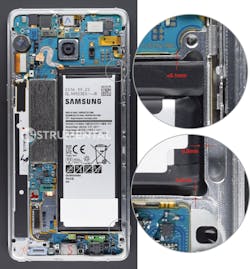This file type includes high resolution graphics and schematics when applicable.
At the time of this writing, we are still waiting for an official announcement from Samsung concerning what caused Galaxy Note 7 batteries to catch fire and explode. However, a manufacturing technology company called Instrumental is suggesting new reasons for this dangerous flaw—among them, that there was no space to allow for swelling of the battery. This insight has led me to think about whether safer regulation and standards for cellphone battery designs should (and could) be implemented.
Instrumental decided to tear down a Galaxy Note 7, owing to a suspicion that the flaw was more than a battery part issue. The firm concluded that the smartphone’s aggressive design was responsible for the battery explosions. “What we found was surprising: The design can compress the battery even during normal operation,” said Anna Shedletsky, Instrumental’s CEO and founder, in a blog entry.
“Any battery engineer will tell you that it’s necessary to leave some percentage of ceiling above the battery [10% is a rough rule-of-thumb],” Shedletsky noted. “Over time, the battery will expand into that space. Our two-month-old unit (see photo) had no ceiling: The battery and adhesive was 5.2 mm thick, resting in a 5.2-mm deep pocket. There should have been a 0.5-mm ceiling. This is what mechanical engineers call line-to-line. And since it breaks such a basic rule, it must have been intentional. It is even possible that our unit was under pressure when we opened it.”
If Samsung—in an effort to innovate—pushed boundaries and consciously built a dangerous product, it begs the question: Should standards be changed to better reinforce the safety of consumers from product fails like this? It is confusing to understand which U.S. entities and international organizations take part in lithium-battery safety standards and regulations, and the roles those involved play. Equally unclear is how device manufacturers deal with battery certification. Some of the organizations that are actively addressing these issues include the Nationally Recognized Testing Laboratory (NRTL), the American National Standards Institute (ANSI), Underwriters Laboratories (UL), the Institute of Electrical and Electronics Engineers (IEEE), and the U.S. Consumer Product Safety Commission (CPSC).
UL, for example, provides safety-related certification, validation, testing, inspection, auditing, advising, and training services to a wide range of clients, including manufacturers, retailers, policymakers, regulators, service companies, and consumers. The key standards are UL 1642, UL 1973, and UL 2580.
Given the crossover between them and the different missions of these organizations, it’s hard to tell which group should step in and at what point. Maybe the Jurisdiction of Consumer Product Safety Commission should change the way it protects consumers by putting in steps to eliminate such product fails. Or should we better reinforce lithium-battery safety standards? Should test and certification procedures for designs change, too?
In an effort to innovate and be number one in the market, many companies are rushing their test and validation procedures. As an engineer, I admire and respect how design engineers are always seeking to innovate in order to increase battery operating times while reducing size and weight.
But as a consumer of electronic products, I think safety should go first. No one wants a cellphone to explode while charging on a nightstand next to their bed or inside their purse or pocket. I believe that stronger standards should be implemented to avoid another major fail design and protect consumers. Yet, such steps must be taken without over-limiting innovation.
What do you think should be done? Feel free to share your opinion with me.
This file type includes high resolution graphics and schematics when applicable.



